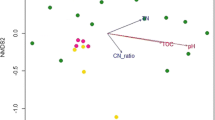Abstract
Microbial communities from the surface of ancient seeds of higher plants and embedding frozen material dated to the late Pleistocene (formed about 30 thousand years ago) were studied by various methods: scanning electron microscopy, epifluorescence microscopy, and inoculation of nutrient media, followed by identification of isolated cultures. Both prokaryotic and eukaryotic microorganisms were found on the surface of ancient seeds. The total quantity of bacterial cells determined by direct counting and dilution plating (CFU) for the samples of ancient seeds exceeded the value in the embedding frozen material by one to two orders of magnitude. This pattern was not maintained for mycelial fungi; their quantity in the embedding material was also rather high. A significant difference was revealed between the microbial communities of ancient seeds and embedding frozen material. These findings suggest that ancient plant seeds are a particular ecological niche for microorganisms existing in permafrost and require individual detailed study.
Similar content being viewed by others
References
Zvyagintsev, D.G., Gilichinsky, D.A., Blagodatskii, S.A., Vorobyova, E.A., Khlebnikova, G.M., Arkhangelova, A.A., and Kudryavtseva, N.N., Duration of Microbial Survival in Permafrost Sedimentary Rocks and Buried Soils, Mikrobiologiya, 1985, vol. 54, no. 1, pp. 155–161.
Vorobyova, E., Soina, V., Gorlenko, M., Minkovskaya, N., Zalinova, N., Mamukelashvili, A., Gilichinskiy, D., Rivkina, E., and Vishnivetskaya, T., The Deep Cold Biosphere: Facts and Hypothesis, FEMS. Microbiol. Rev., 1997, no. 20, pp. 227–290.
Rivkina, E., Gilichinskiy, D., Wagener, S., Tiedje, J., and McCrath, J., Biogeochemical Activity of Anaerobic Microorganisms from Buried Permafrost Sediments, Geomicrobiology, 1998, no. 15, pp. 187–193.
Vishnivetskaya, T.A., Erokhina, L.G., Gilichinskii, D.A., and Vorobyova, E.V., Blue-Green Algae from Arctic Permafrost Sedimentary Rocks, Kriosfera Zemli, 1997, no. 2, pp. 71–76.
Gubin, S.V. and Khasanov, B.F., Fossil Burrows of Mammals in the Loess-Ice Deposits of the Kolyma-Indigirka Lowland, Doklady AN, 1996, vol. 346, no. 2, pp. 278–279 [Doklady Biol. Sci. (Engl. Transl.), vol. 346, pp. 26–27].
Zanina, O.G., Fossil Rodent Burrows from Frozen Late Pleistocene Deposits of the Kolyma Lowland, Zool. Zh. 2005, vol. 84, no. 6, pp. 728–736.
Gubin, S.V., Maksimovich, S.V., Davydov, S.P., Gilichinsky, D.A., Shatilovich, A.V., Spirina, E.V., and Yashina, S.G., Possible Participation of the Late Pleistocene Biota in Formation of the Biodiversity of the Modren Cryolithozone, Zh. Obshch. Biol., 2003, vol. 64, no. 2, pp. 160–165.
Yashina, S.G., Gubin, S.V., Shabaeva, E.V., Egorova, E.F., and Maksimovich, S.V., Viability of Higher Plant Seeds of Late Pleistocene Age from Permafrost Deposits as Determined by in vitro Culturing, Doklady AN, 2002, vol. 383, no. 5, pp. 714–717 [Doklady Biol. Sci. (Engl. Transl.), vol. 383, pp. 167–170].
Simon, H.M., Smith, K.P., Dodsworth, J.A., Guenthner, B., Handelsman, J., and Goodman, R.M., Influence of Tomato Genotype on Growth of Inoculated and Indigenous Bacteria in the Spermosphere, Ap. Environ. Microbiol., 2001, vol. 67, no. 2, pp. 514–520.
Mishustin, E.N. and Trisvyatskii, L.A., Mikrobiologiya zerna i muki (Microbiology of Grain and Flour), Moscow: Khleboizdat, 1960.
Center of Prospective Technologies, http://www.spm.genebee.msu.su/manual/en/index.html
Wan, C.P., Sigh, R.V., and Lau, B.H.S., A Simple Fluoremetric Assay for the Determination of Cell Number, J. Immunol. Methods, 1994, vol. 173, pp. 265–272.
Metody eksperimental’noi mikologii (Methods for Experimenta Mycology) Bilai, V.I., Ed., Kiev: Naukova Dumka, 1982.
Ainsworth & Bisby’s dictionary of the fungi, Kirk, P.M., Cannon, P.F., David, J.C., and Stalpers, J.A., Eds., 9th ed. Wallingford, UK: CABI Publishing, 2001.
Gilichinsky, D., Wagener, S., and Vishnevetskaya, E., Permafrost Microbiology, Perm. Periglac. Processes, 1995, vol. 6, pp. 281–291.
Rivas, R., Velazquez, E., Willems, A., Vizcaino, N., Subba-Rao, S., Mateos, P.F., Gillis, M., Dazzo, F.B., and Martinez-Molina, E., A New Species of Devosia That Forms a Unique Nitrogen-Fixing Root-Nodule Symbiosis with the Aquatic Legume Neptunia natans (L.f.) Druce, Appl. Environ. Microbiol., 2002, vol. 68, pp. 5217–5222.
Viegas, M., Del Carmen, Rome S., Maure, L., Domergue, O., Gardan, L., Bailly, X., Cleyet-Marel, J.C., and Brunel, B., Nitrogen-Fixing Sinorhizobia with Medicago laciniata Constitute a Novel Biovar (bv. medicaginis) of S. meliloti, Syst. Appl. Microbiol., 2006, vol. 29, pp. 526–538.
Mannisto, M.K., Schumann, P., Rainey, F.A., Kampfer, P., Tsitko, I., Tiirola, M.A., and Salkinoja-Salonen, M.S., Subtercola boreus gen. nov., sp. nov. and Subtercola frigoramans sp. nov., Two New Psychrophilic Actinobacteria Isolated from Boreal Groundwater, Int. J. Syst. Evol. Microbiol., 2000, vol. 50, pp. 1731–1739.
Sheridan, P.P., Loveland-Curtze, J., Miteva, V.I., and Brenchley, J.E., Rhodoglobus vestalii gen. nov., sp. nov., a Novel Psychrophilic Organism Isolated from an Antarctic Dry Valley Lake, Int. J. Syst. Evol. Microbiol., 2003, vol. 53, pp. 985–994.
Kinsey, G.C., Descriptions of Fungi and Bacteria, IMI Descriptions of Fungi and Bacteria, 2002, vol. 151, sheet 1504, http://www.cababstractplus.org/DFB/Reviews.asp?action=display&openMenu=relatedItems&ReviewID=10613&Year=2002.
Tosi, S., Onofri, S., Brusoni, M., Zucconi, L., and Vishniac, H., Response of Antarctic Soil Fungal Assemblages To Experimental Warming and Reduction of UV Radiation, Polar Biology, 2004, vol. 28, no. 6, pp. 470–482.
Del Frate, G. and Caretta, G., Fungi Isolated from Antarctic Material, Polar Biology, 1990, vol. 11, no. 1, pp. 1–7.
Ozerskaya, S.M., Ivanushkina, N.E., Kochkina, G.A., Fattakhova, R.N., and Gilichinsky, D.A., Mycelial Fungi in Cryopegs, Int. J. Astrobiol., 2004, vol. 3, no. 4, pp. 327–331.
Kochkina, G.A., Ivanushkina, N.E., Akimov, V.N., Gilichinsky, D.A., and Ozerskaya, S.M., Halo-and Psychrotolerant Geomyces Fungi from Arctic Cryopegs and Marine Deposits, Mikrobiologiya, 2007, vol. 76, no. 1, pp. 36–43 [Microbiology (Engl. Transl.), vol. 76, no. 1, pp. 31–38].
Vtyurin, B. and Bolikhovskii, V., Edoma. Problemy i zagadki. Polyarnyi krug (Yedoma. Problems and Enigmas. Polar Circle), Moscow: Mysl’, 1980, pp. 265–271.
Author information
Authors and Affiliations
Corresponding author
Additional information
Original Russian Text © V.L. Stakhov, S.V. Gubin, S.V. Maksimovich, D.V. Rebrikov, A.M. Savilova, G.A. Kochkina, S.M. Ozerskaya, N.E. Ivanushkina, E.A. Vorobyova, 2008, published in Mikrobiologiya, 2008, Vol. 77, No. 3, pp. 396–403.
Rights and permissions
About this article
Cite this article
Stakhov, V.L., Gubin, S.V., Maksimovich, S.V. et al. Microbial communities of ancient seeds derived from permanently frozen Pleistocene deposits. Microbiology 77, 348–355 (2008). https://doi.org/10.1134/S0026261708030156
Received:
Published:
Issue Date:
DOI: https://doi.org/10.1134/S0026261708030156




